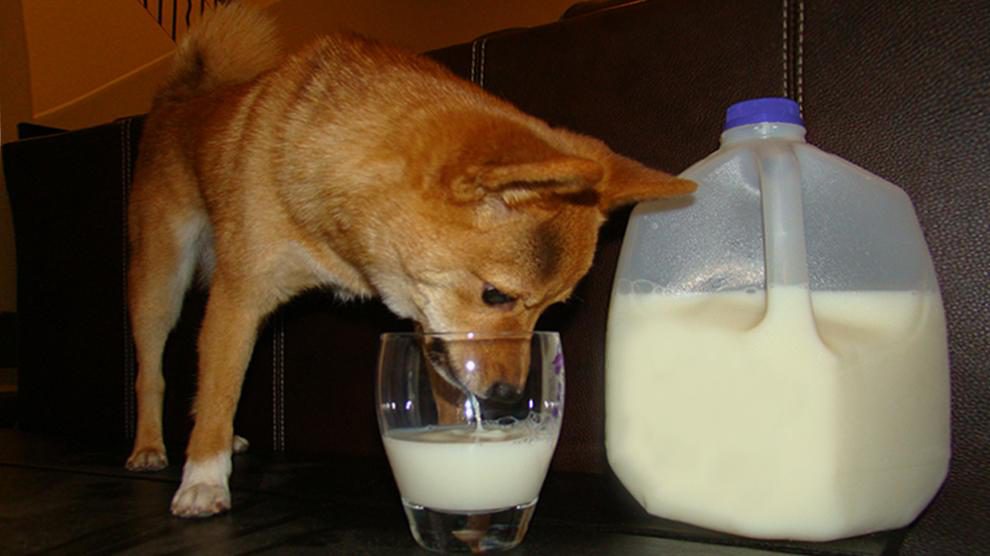Last Updated on July 10, 2021 by Fumipets
Throughout history, fresh, raw, and fermented milk have been relished by people all over the globe. These are derived from a wide range of animals, including goats. You may be shocked to discover that goat milk (rather than cow milk) is the most widely consumed milk on the planet.
Researchers have discovered that the content of milk differs by species. So much so that goat milk may be a suitable alternative to cow milk.
So, today, we’ll discuss the benefits and disadvantages of goat milk, as well as how to feed it to your dog.
Why Goat Milk May Not Be Right For Your Dog
There are four major reasons why you should think twice about adding goat milk to your dog’s diet.

1. Lactose Intolerance
You want to be sure your dog isn’t lactose intolerant before you start adding dairy to her diet.
Dairy may cause digestive problems in dogs, just as it does in people. This occurs when their systems are unable to handle lactose, a milk sugar found in dairy products. Lactase, a digestive enzyme, is required to break down these sugars in your dog. Regrettably, not all dogs generate sufficient amounts of this enzyme. As a result, they may develop dairy sensitivities and allergies.
Whether you’re not sure if your dog has an allergy to dairy, start with little amounts at first. Keep an eye out for negative responses and quit if you see any. Lactose intolerance may be identified by the following symptoms; Diarrhea, Bloating, Abdominal discomfort, Gas, Vomiting, Loss of appetite
The good news is that your dog may be able to digest goat milk easier if she just has minor lactose sensitivity. This is due to the fact that goat milk has 12% less lactose than cow milk.
2. Fat Content
Cows milk container, as you may be aware, displays various percentages… often 1 to 3 percent. This refers to the milk’s fat content.
The fat content of goat milk is typically about 4%. That’s more fat than most individuals get from cow milk, and the majority of it is saturated.
Due to worries about cholesterol, most people attempt to avoid eating too much saturated fat. Saturated fats don’t have the same impact on dogs, therefore this isn’t a problem. That said, the saturated and unsaturated fats in your dog’s diet should be balanced. If you give goat milk to your dog, be sure to balance out the saturated fat with healthy unsaturated fats.
If your dog has (or is at high risk of) pancreatitis, you should limit the amount of fat he eats. Pancreatitis, or pancreatic inflammation, necessitates a low-fat diet.
While low-fat or fat-free products may seem to be a smart choice, it is advisable to avoid them. The fat has been removed from these items during processing. As a result, they may raise the risk of diabetes and obesity.
3. Higher Calories
Cow milk has less calories than goat milk. A cup of goat milk has 170 calories, while a cup of cow milk includes just 90 to 150 calories.
If you’re giving your dog milk (goat or otherwise), you’ll need to modify her diet to accommodate the extra calories. This can help you avoid overfeeding your dog and decrease the danger of obesity in your pet.
4. Skin and Digestive Problems
Dairy products have the potential to cause inflammation. One of the major causes of skin and intestinal issues is inflammation. (In reality, it plays a role in the development of many chronic illnesses.)
Proteins, hormones, and sugar are among the ingredients in milk that promote inflammation.
Whey proteins, which are found in milk, are one of the main causes of inflammation. Whey proteins are found in both goat and cow milk, although goat milk has a greater concentration. In terms of sugar content, goat milk is lower than cow milk, although the difference is just 1 gramme per cup.
If your dog has a history of skin or stomach problems, it’s best to avoid dairy products altogether.

Why Is Goat Milk A Better Alternative To Cow Milk?
While dogs and humans need different types of nourishment, there are some similarities. Goat milk also contains a variety of essential vitamins, minerals, enzymes, protein, and fatty acids.
Vitamins, minerals, electrolytes, trace elements, enzymes, protein, and fatty acids are all found in goat milk.
Goat milk is a greater source of Protein, Fat, Phosphate, Calcium, Potassium, and Vitamin C
However, this isn’t the sole advantage of goat milk.
1. It’s A Lot Easier To Digest
As I previously said, goat milk has less lactose than cow milk. However, lactose intolerance isn’t the sole cause of milk allergies in dogs (or humans). Goat milk has a number of characteristics that make it simpler to digest than other types of milk.
One of the main reasons goat milk is gentler on the stomach is the kinds of proteins it contains.
In milk, there are two kinds of proteins…
Caseins are a kind of protein (make up about 80 percent of the total proteins)
In cow milk, alpha-s1 casein is a significant protein. It may induce inflammation and is one of several proteins that might trigger an allergic reaction in your dog. Because goat milk has a lower concentration of this protein, it may be less prone to cause problems.
You may also be familiar with the terms A1 and A2 milk. This is a reference to the beta-casein proteins found in cow’s milk. A2 milk includes just A2 beta-caseins, while regular milk contains both proteins. A2 milk is said to provide additional health advantages, including being simpler to digest. Goat milk includes just A2 beta-casein, which may help with digestion.
Serum proteins
Cow milk differs from goat milk in terms of beta-lactoglobulin and alpha-lactalbumin (whey proteins). This may also be the cause of any food sensitivity your dog has.
Cow milk has a long number of allergen-inducing proteins. According to studies, it contains around 20 distinct proteins that may induce allergic responses.
Cow milk is difficult to digest for a variety of reasons, not simply proteins and lactose. There are a number of reasons why goat milk may be accepted better than cow milk.
Goat milk has smaller fat globules and a h igher concentrations of small and medium chain fatty acids. Also, the Curd formation is looser
All of this enables your dog to absorb goat milk considerably more rapidly and efficiently. In fact, goat milk may be digested in 20 minutes. Its lipid molecules are one-fifth the size of those in cow’s milk, making it readily digested… which is why it may be tolerated by dogs with digestive problems.
2. Probiotics And Prebiotics
Probiotic bacteria are good bacteria that help your dog’s general health. They may be ingested or used as supplements. The living microorganisms pass through the digestive system of your dog. They’ll proliferate in your dog’s colon if they survive the severe circumstances of her digestive system.
The stomach contains almost 90% of your dog’s immune system. As a result, maintaining a healthy balance of good and harmful bacteria is critical for your dog’s general health.
However, these helpful bacteria need nourishment in order to function properly. Prebiotics have a role in this. Prebiotics are non-digestible fibres that aid in the growth and survival of helpful microorganisms.
Unpasteurized milk may be a source of probiotics, according to the Raw Milk Institute. Oligosaccharides, a kind of prebiotic found in goat milk, are also present. It also contains six times as much natural prebiotics as cow’s milk.
Prebiotic content may be increased by fermenting goat milk to produce kefir and yoghurt. Because the fermentation process may convert milk carbs into oligosaccharides, which are a kind of prebiotic, this is the case. But we’ll get into fermented milk later… for now, let’s concentrate on unfermented goat milk.
3. Calcium Supplementation
Goat milk provides 330 mg of calcium per cup. This is far more than the 100 to 275 mg found in a cup of cow milk.
Calcium is required for the neuromuscular, cardiovascular, immunological, and endocrine functioning of your dog.
4. Better Absorption of Nutrients
Copper and iron are trace minerals that are essential for your dog’s health. Iron is necessary for healthy bodily function and delivers oxygen to your dog’s organs and muscles. Copper is required for iron absorption as well as the prevention of anaemia. (Anemia is a blood disease in which the body lacks sufficient oxygen.)
Cow milk has been shown to interfere with the body’s ability to absorb copper and iron. With goat milk, however, this is not the case.
Researchers looked at how much copper and iron rats absorbed after drinking goat milk. They discovered that it was comparable to those who did not have any milk at all. This may aid in the prevention of malabsorption.
Magnesium and phosphorus digestibility may also be improved by goat milk. These minerals are essential for bone formation as well as other activities.

When To Avoid Goat Milk
It’s entirely up to you whether or not you want to feed your dog goat milk. However, there are occasions when you’ll wish to avoid it.
1. If your dog is suffering from skin or digestive problems.
As previously stated, I f your dog has digestion or skin problems, it’s better to avoid dairy altogether.
2. If Your Dog has Cancer
Dairy, whether raw or fermented, includes proinflammatory proteins. Inflammation is a significant risk of cancer, therefore any meal that may induce it should be avoided.
4. If Your Dog Obese Or Suffering From Pancreatitis?
The fat in goat milk may be inappropriate for your dog if she is overweight or has pancreatitis.
4. If your Dog Is Intolerable
While goat milk may be simpler for some dogs to stomach, if your dog is allergic to dairy, she may still have issues. If you wish to give it a try, start with very tiny quantities to prevent upset stomachs in your dog.
Fermented Goat Milk
Fermentation may provide additional nutritional benefits. Kefir and yoghurt are made from milk that has been fermented.
Despite the fact that fermented milk and dairy dishes have been consumed for thousands of years… We’ve just lately started to comprehend how they aid in the treatment of contemporary chronic diseases like Arthritis, Irritable bowel syndrome (IBS), Gastric Ulcers, Colitis, Intestinal pathogens and brain disorders
Fermented foods are popular because they are said to be high in probiotics. However, this isn’t completely accurate. Fermented foods include probiotics, but they’re weak strains that won’t make it past your dog’s digestive system.
That implies that by the time they reach your dog’s colon, they’re already dead. As a result, they are unable to colonise and offer probiotic advantages. Fermented foods, on the other hand, are still beneficial to your dog, although for a different purpose.
Fermented foods are high in prebiotics, which nourishes the good bacteria in your dog’s stomach. They also have postbiotics, which are bacteria that are produced after the fermentation process. Postbiotics are metabolites that have health-promoting properties. Short-chain fatty acids (SCFAs) are one of the most significant postbiotics that;
Stop the spread of dangerous germs.
Keep the cells of your dog’s gut lining together, to avoid leaky gut
Boost the immune system
Reduce inflammation
Incorporating raw fermented milk into your dog’s diet may also offer the following benefits: Enzymes, Probiotics, Powerful Antioxidants, Fatty acids, Concentrated vitamins (such as essential vitamin K2) as well as trace minerals
…and it’s all in the shape of a whole, complete food.
Fermented dairy products are also simpler to digest for the majority of dogs. They include enzymes that aid in nutrition absorption.

When Should Fermented Foods Be Avoided?
Avoid feeding fermented foods to your dog if she has a yeast infection.
Bacteria and yeast “eat” the carbs and sugars in the meal to ferment it. As a result, the prebiotics that feed the yeast in fermented foods will nourish the yeast in your dog’s stomach as well.
You may believe that feeding your dog healthy fermented foods is beneficial. However, it may exacerbate skin problems like yeast.
How to Give Goat Milk to Your Dog
As you can see, goat milk has a lot of advantages and disadvantages. If you decide to try goat milk, make sure you get a high-quality product.
The nutritional content of goat milk is determined by the goats’ diet and general health. You’ll receive considerably better milk from goats that have been…
Organically grown
Grass-fed and pasture-raised
In a low-stress setting
antimicrobial-free
Raised with feeds that are free of genetically modified organisms
You should also seek out raw milk. Because it is unprocessed and high in lactase enzyme, it is the best option. The nutritious value of milk is reduced when it is pasteurised or spray dried. It also eliminates the lactase enzymes present in milk. Pasteurized milk is indigestible to many humans and dogs that lack the lactase enzyme. Raw milk, on the other hand, is not an issue for them.
Some may claim that pathogens exist in raw milk. However, the quality of any meal is only as excellent as the source. The danger is significantly minimised if you purchase raw milk from a trustworthy supplier.
Make sure you’re using raw goat milk or kefir if you’re using fermented goat milk or kefir. Lactic acid bacteria grow best in unprocessed milk that hasn’t been destroyed by extreme heat. The bacteria in raw goat milk are also less likely to be damaged by hydrochloric acid and bile salts in digestive fluids in the digestive system.
Conclusion
Start slowly if you’re feeding your dog goat milk or dairy for the first time. Gradually increase to the suggested quantity. Keep an eye out for symptoms of stomach distress or intolerances, and reduce down or stop if required.
Remember that if you add goat milk to your dog’s meals, you’ll need to decrease the amount of food your dog eats to compensate for the goat milk calories. When feeding commercial raw, 1 oz of food typically has approximately 60 calories. This is about 3 ounces of goat milk.
Goat milk has certain advantages, but it isn’t nutritionally essential, and in rare instances, it may exacerbate health issues.
When determining whether or not your dog need goat milk, take your time. Consider all of the advantages and disadvantages.


















